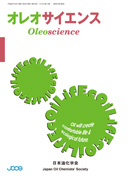All issues

Volume 7, Issue 1
Displaying 1-3 of 3 articles from this issue
- |<
- <
- 1
- >
- >|
-
Masahiko SHIBATA, Yasushi KAJI2007Volume 7Issue 1 Pages 5-11
Published: January 01, 2007
Released on J-STAGE: June 01, 2013
JOURNAL FREE ACCESSAs green chemistry activities have spread across the world, it has got more important to evaluate and show accurately the degree of their environment-friendliness. This paper took up life cycle assessment (LCA) as a way of estimating and showing the effect of green chemistry activity and give an outline of it. Additionally this paper explained the merits and important reminders of application of LCA through introduction of some application examples.View full abstractDownload PDF (1997K) -
Masayuki TODA, Seiji URYU2007Volume 7Issue 1 Pages 13-18
Published: January 01, 2007
Released on J-STAGE: June 01, 2013
JOURNAL FREE ACCESSThe cleaning of wafer surface in the semiconductor manufacturing process has been carried out on the basis of RCA cleaning procedure proposed by W. Kern et al in 1970. This method uses the cleaning solutions prepared by the respectively mixing of sulfuric acid, ammonia, hydrochloric acid, etc on the basis of hydrogen peroxide, and it is a batch cleaning process in relatively high temperature. Therefore, the problems such as the contamination by chemical vapor in the clean room and the increase of ultra pure water necessary for the rinse of chemicals on wafer surface occurred. The new cleaning procedure was proposed in order to solve the above-mentioned problems. In this method, the consumption volumes of ultra pure water and chemicals are very small, and also the functional water such as ultrasonic wave excitation water, ozonized water and so on are utilized. At the present time, a lot of water called as the functional water widely exists, and there are so many cleaning methods by the functional water in the required fields.
In the present paper, some part of the functional water which is fundamental to cleaning by functional water will be explained briefly.View full abstractDownload PDF (1113K) -
Masaru OYA2007Volume 7Issue 1 Pages 19-26
Published: January 01, 2007
Released on J-STAGE: June 01, 2013
JOURNAL FREE ACCESSThe effects of surfactants on aquatic environment have been argued based on the points of aquatic acute toxicity, No Observed Effect Concentration, biodegradability, and so on. Recently, however, risk assessment has been applied to estimate the environmental acceptability of surfactants where ratio of Maximum Permissible Concentration (or NOEC) to Predicted Environmental Concentration is used as an indicator. Resent researches indicate that the major surfactants used in household laundry or cleaning product do not exert a harmful influence on aquatic environmental systems of rivers in Europe and/nor Japan. In future, new risk assessment methods considering the effect of water quality such as water hardness on the aquatic toxicity and the surfactant's character of adsorption on suspended materials in the natural water environment should be developed. In addition, the method to indirectly calculate NOEC of surfactants using acute toxicity data should be improved. Risk assessment of surfactants in aquatic environment should play a leading role in the study on evaluating chemical risks.View full abstractDownload PDF (1375K)
- |<
- <
- 1
- >
- >|